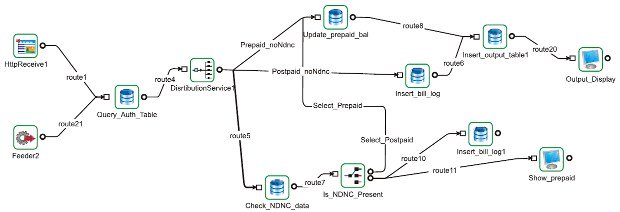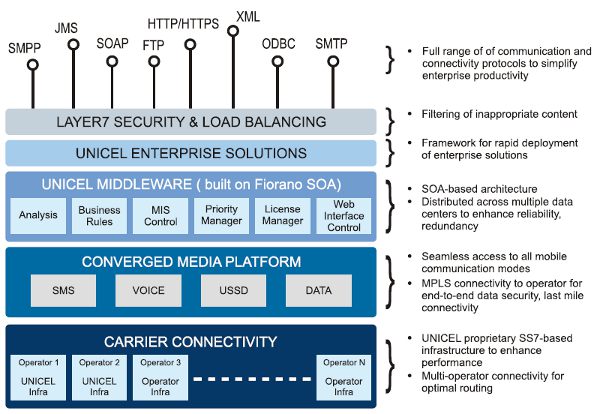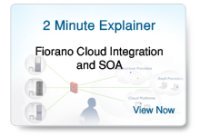Deploys Fiorano SOA platform as the middleware backbone for seamless integration delivering high performance, flexibility and scalability.

Customer Profile
UNICEL is an industry specialist and leading provider of wireless enterprise mobility solutions. The company uses the versatile platform of mobile telephony to offer innovative customized solutions to organizations across functional areas. It is a leader in Enterprise Messaging Solutions (EMS) and provides 'cutting-edge' technology and marketing solutions in wireless telecom. One of the Company's core strengths is the ability to provide these solutions on its own proprietary SS7-based infrastructure deployed across multiple Mobile Network Operators, enabling it to lead the market in performance and reliability of its solutions.
GlobalOne, which is the company's flagship product, is a web based user interface that enables users to manage incoming and outgoing messages by creating different keywords, setting auto responses and assigning a different incoming path like an email or URL. The platform also enables an enterprise to send bulk messages in a single push.
Business Problem
Unicel is using IBM servers running on a LINUX environment and Apache web-servers. Prior to implementing the Fiorano solution, Unicel deployed multiple C, C++ and Java based applications to create, execute and manage the message processing logic in effect, trying to play the role of middleware. The highly resource intensive process based on these applications was being used to implement the business logic of fetching data from a file or central database, executing various processing and data validity checks based on message priority, and finally passing on the processed data to SMS gateways. These checks included Do Not Disturb checks, Prepaid credit management, Priority management, Blacklist check, Content filter, Sender ID check, Message time to live (TTL), Transaction per Second (TPS) requirements etc.
The point to point nature of connections between these different applications made scalability of the system a challenge and proved to be a very expensive proposition that fell short of enterprise performance, reliability, scalability and affordability goals. Unicel's setup was, therefore, best characterized as extremely non-scalable, accompanied by limited reuse of, and inability to extract information from, heterogeneous software assets.
Performance Shortcomings: Unicel suffered from a lack of service virtualization which limited the concurrent flow of multiple business processes and reduced throughput and performance. Unicel's SMS handling capabilities, for instance, were limited at about 10 to 15 million messages per day, unless significant investments were undertaken to expand capacity.
Reliability & Security Shortcomings: Unicel employed a two-tier architecture - a database running in the background and a web layer on top. As a result their database was exposed to multiple applications which made direct calls to it. Furthermore, as part of the front-end architecture it was vulnerable to security risks such as integrity attacks and misuse; failover capabilities suffered concomitantly.
Scalability Shortcomings: The same components, like login handler, had to be re-written for every new application that required to be integrated. The email functionality, too, suffered from a similar predicament. Software asset reuse was, therefore, severely limited, adding a layer of costs and increased time to market.
High Total Cost of Ownership: Unicel measured their return on investment along two vectors direct costs & indirect benefits. While the requirement to add more hardware to accommodate newer functionality increased direct costs, meeting customer SLAs and attending to system downtimes added to indirect costs and time overruns in the pre-Fiorano setup.
Selection Process
Unicel were in the market for building a distributed, fault-tolerant, multi-tiered environment based largely on modular components.
Unicel were traditionally using JAVA in a very limited manner with only one SMPP server based on JAVA. Mr. Vinay Agrrawal, Managing Director, Unicel Technologies, and his team started researching various options available in the market ranging from open source to large and complex vendor offerings for solving their middleware problems.
Some of the key criteria were:- Ability to handle high speed messaging
- High scalability
- Automated redundancy
- Ease of use (GUI and interfaces)
- Minimal requirement for complex coding
- Consulting service costs and Total Cost of Ownership
On a detailed evaluation they concluded that many of the offerings were not designed bottom up as an ESB product, but were rather only pushing "message-broker" as the solution to their middleware revamping problem. This approach would leave gaps in their functionality requirements. They were also not very cost effective, some requiring custom coding and extensive use of consulting services for implementation.
After conducting a rigorous Proof-of-concept, the Architectural and Engineering Team at Unicel picked Fiorano as the preferred solution that met all their criteria.
Fiorano delivered a high-performance, low-latency messaging solution, a key requirement in telecommunications where high-throughput is critical to business performance.
Telecommunications practice also demands real-time event processing, another one of Fiorano ESB's key strengths. In addition, business flows can be modified dynamically (i.e. changes to the flow do not require the flow to be stopped & redeployed), which is necessary for mission-critical, 24x7 environments. Automatically configuring the underlying middleware allows the logical process design to be mapped directly to physical services distributed across the ESB, empowering non-technical business-users to compose, deploy, and modify event-driven business processes.
"We have ambitious plans, and executing those in the current competitive environment required investment in a reliable, scalable high performance infrastructure. With Fiorano we have achieved a positive ROI on our SOA implementation in just a few months. Message processing capability has increased five-fold and SLA commitments have improved by 80%. Most importantly, it has given us a clear line of sight for increasing performance by another five-fold in the coming months. It has been a tremendous force multiplier for us." he added.
Implementation
Using the Fiorano platform, Unicel has created application flows which automate their business logic of fetching data from a file or central database, executing multiple complex processing and data validity checks based on message priority, and passing on the final processed data to SMS gateways, all the while providing transactional visibility into these operations.
The figure below illustrates a sample application flow depicting how Unicel's business logic was implemented using SOA components on the Fiorano studio. The data is read from a file using a File Reader component or fetched from a web page using the Http Receive component. The database component is used to carry out various validation checks on the fetched set of data. Content Based Routing (CBR) component is then used to route the data across various message paths based on the content of the message. Finally, the XSLT component along with various flow based components like XML Splitter, Join, Aggregator, etc. are used to process the messages before sending them across to SMS gateways.

Sample Application Flow for Unicel Business Logic
Using Fiorano's advanced componentized model, software reuse is maximized, business flows only need to be designed once and then can be replicated easily across multiple installations of the Fiorano peer server world-wide. Given the repeatable model that Unicel requires for their operations, this feature provides a very efficient and cost-effective way of quickly deploying a new instance of the application. With advanced management features, reliable delivery of messages and enhanced messaging speed they are able to asynchronously manage their JMS based logic with the Fiorano SOA platform.
The diagram below shows Unicel's layered architecture; the Unicel Middleware layer, built entirely on the Fiorano platform, manages its most crucial operations and provides a vital active data bus between its lower level and higher level layers.
Benefits
Multiplied Performance - With the Fiorano platform in place, Unicel has been able to multiply its performance five-fold. Recently, they were able to achieve transmission of a record 52 million messages in a single day at the operator end, which was an unprecedented landmark for the company. According to Mr. Vinay Agrrawal trying to achieve this kind of number, prior to implementing Fiorano's middleware solution, would not have been possible.
Enhanced Security - Added security to the database layer as the entire logic of handling database connections is now controlled from the back-end; with Fiorano ESB in the middle, the database is no longer vulnerable to security risks at the top end.
Flexibility & Reliability - Instead of writing one functional component (like login and email), 10 times for 10 different applications, they write it just once and then have each of their applications make HTTP calls to it. With Fiorano ESB middleware no separate piece of code is required to process conversions between different applications. With a trusted failover mechanism, it adds up to a highly reliable and flexible environment.

High Scalability - When Unicel needs to add more servers to address their constantly growing application, they just need to replicate existing components and connect to the ESB, obviating the previously required method of writing long sets of code or having to replicate entire databases.
Productivity Gains and Reduced Costs - With the Fiorano platform taking care of data-flow between different components, transformation code does not need to be written across multiple applications where these components were being re-used. This led to a direct increase in productivity and reduced overall cost of development.
Quality of Service - With implementation of a sophisticated SOA architecture, built on the Fiorano SOA Platform, Unicel has been able to not only meet its SLA agreements but also beat them by over 80%. It has also helped them drastically reduce their server downtimes, resulting in significantly higher standards of quality.
Vision for the future
Spurred by the tremendous success of the implementation of the Fiorano solution, Mr. Vinay Agrrawal now has big plans for the future. He intends to expand their Fiorano middleware usage to include non-critical applications as well. In addition to the currently active SMS service, his team plans to move multiple services such as Voice and Data and their complete billing system onto the Fiorano platform where middleware will be the key in generating call detail records (CDRs). They are also planning to implement their own in-house ERP system integrated across Tally with the whole provisioning system running on the Fiorano SOA platform.
Crucial bottlenecks in performance will be eliminated by integrating the complete enterprise layer through the Fiorano ESB. As their web usage increases incrementally over the next few months, this will be a key process change for Unicel.
About Fiorano Software
Founded in 1995, Silicon Valley based Fiorano is a California Corporation with proven leadership in enterprise middleware and peer-to-peer distributed systems. Fiorano's innovative event-driven, dataflow SOA platform integrates applications and complex technologies into an enterprise nervous system, increases business process performance, yields higher message throughput and enhances availability through agent-based visual composition that bridges the capability gap between business models and their implementation - the model is the application, ready to run.
Global leaders including ABN AMRO, Boeing, British Telecom, Chicago Mercantile Exchange Group, McKesson, NASA, POSCO Steel, Qwest Communications, Rabobank, Schlumberger, Lockheed Martin, United States Coast Guard and Vodafone have deployed Fiorano to drive innovation through open, standards-based, dataflow SOA applications built in just days, yielding unprecedented productivity.
Fiorano Enterprise Service Bus (ESB) and Fiorano Message Queue (MQ) deliver the industry fastest, lowest latency, highest throughput real-time messaging (asynchronous and synchronous) to power high performance, highly available, and collaborative workflow applications whose application services are distributed throughout the IT landscape. Fiorano's distributed, peer-to-peer agents' abstract complexity of developing and deploying services to unlock value in a customer's enterprise architecture framework.
To find out more about how Fiorano can help you meet your enterprise integration objectives, visit www.fiorano.com or Email: sales@fiorano.com.

 Japan
Japan Germany
Germany

